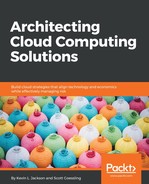Redundant single site designs can often handle many of the more prevalent issues that cause downtime within infrastructure layers. What happens if the entire site is not reachable? What happens if something gets misconfigured in DNS that sends traffic the wrong direction? The single site is now unreachable. Traditionally, the answer to this challenge has been very expensive. The redundant single site design nearly doubled the cost of infrastructure. For geographic redundancy, a second site is needed. This second site effectively doubles the budget of the first site, which already doubled when redundancy was added to the first design.
Cloud solutions are dramatically changing the way we design redundancy, resiliency, and disaster recovery. The cloud changes the fundamentals of base designs. For example, we are now able to design for low-side, base-level traffic flows, instead of designing for anticipated high-watermark levels. The cloud enables dramatic changes in footprint size and the amount of redundant infrastructure needed in single site and multiple site designs. The cloud is also changing the consumption patterns for infrastructure. Some applications traditionally deployed in-house have transformed to SaaS offerings, eliminating the need for the associated in-house infrastructure. The reduction in single site footprints can also reduce the size of second site footprints, helping redundant strategies fit into budgets easier than traditional deployments.
When planning redundancy across multiple data centers, new design challenges need consideration. How is traffic sent to one location or the other? Is one site active and one backup? Are both active? How does fail-back to the primary get handled after the failure occurs? What changes in resiliency plans are needed? How is data synchronization handled before and after failover?
